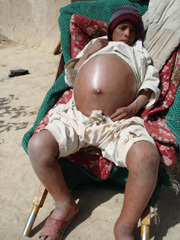
|
| ©Khalid Nahez/IRIN |
| Charmak disease - also known as camel belly - is caused by exposure to pyrrolizidine alkaloids found in Charmak weed which grows in grain fields, WHO says |
Citing the result of tests at the National Institute for Public Health in the Netherlands, the UN World Health Organization (WHO) said the disease was caused by exposure to pyrrolizidine alkaloids found in 'charmak', a poisonous weed believed to be growing mostly in grain fields in Gulran District, and which often finds its way into locally produced wheat flour.
According to WHO, regular consumption of bread contaminated by alkaloids contained in the weed can cause rapidly filling ascites (also known as peritoneal cavity fluid, peritoneal fluid excess, hydroperitoneum or abdominal dropsy), severe abdominal pain, vomiting and jaundice.
"VOD of the liver is a form of toxic liver damage caused by pyrrolizidine alkaloids," WHO said.
The outbreak of 'charmak' disease was first reported in November 2007. Of the 17 deaths six were men, six were women and five children, according to Herat's public health department.
"Thirty eight other patients are currently under medical testing which will determine whether or not they have 'charmak' disease," Aziz Noorzai, the head of Gulran hospital, told IRIN on the phone on 14 May.
"No magic pill"
Until early May local health officials did not know what medication should be given to 'charmak' patients to cure their illness.
Medical experts now say - based on the Netherlands test results - that two grams of sodium in the daily diet, the use of vitamin and mineral supplements, and the extraction of unnecessary liquids from a patient's swollen belly in serious cases, can save lives and treat the disease, according to Rana Graber Kakar, a WHO expert in Kabul.
"There is no magic pill for it," said Kakar, adding that technical research and studies were under way to illuminate characteristics of the disease and help the Ministry of Public Health (MoPH) to overcome similar challenges in future.
Rest is also recommended for long-term recovery, she said.
Food aid distributed
In an effort to curb the outbreak, the MoPH has launched a public awareness campaign in Gulran District through which people are encouraged to stop consuming locally produced flour.
But the drive has been received coldly by most of Gulran's poor populace.
"When we tell them not to eat Gulran flour, they ask what they should eat instead," said Noorzai.
The UN World Food Programme (WFP) said it had distributed 700 tones of mixed food items to about 55,000 people in Gulran under food-for-work and education incentive schemes, and a further 860 tonnes would be distributed to 24,000 people in the near future.
An Italian Provincial Reconstruction Team has also delivered food and non-food relief items to vulnerable families, the NATO-led International Security Assistance Force said in a statement on 28 April.
Improved wheat cultivation needed
'Charmak' has appeared at least three times in the past 50 years - always in Herat Province - and had affected hundreds of people each time, according to local officials.
Health experts said the disease cannot be prevented through medical measures only, but that improvements in wheat cultivation, harvesting, threshing and milling - and enabling farmers to eliminate poisonous weeds in their fields - would help avert future outbreaks.
"In the long-term, the government needs to focus on agricultural policies that will reduce contamination of grain with Heliotropium ['charmac'] weeds," the WHO said in a weekly epidemiological monitor on 11 May.



Reader Comments
to our Newsletter